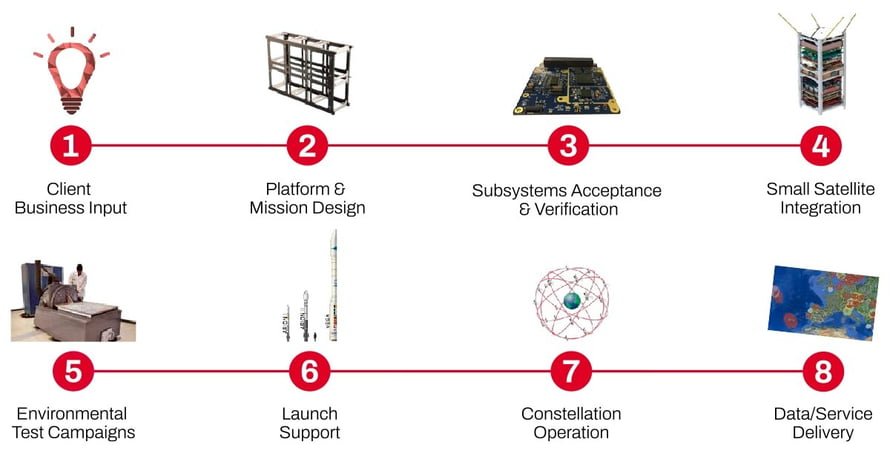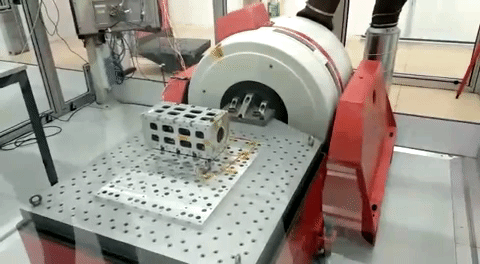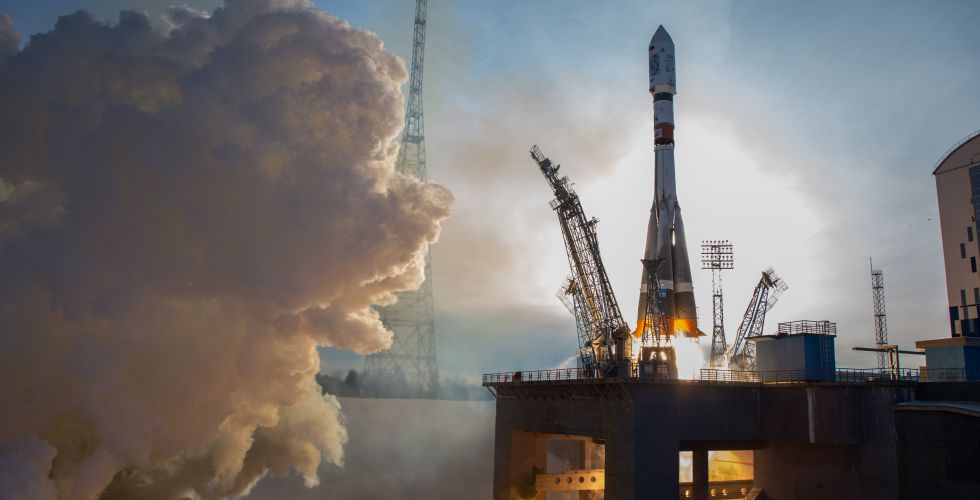
When we talk about the New Space age, every second counts. If a few decades ago there was talk of the “space race” between the United States and the Soviet Union, today there has been no change in the need to be the first... or to reach space earlier than the competition. The difference is that what was once a tug of war between two superpowers (and no one else) is now a much more open race, including many other countries and private companies that have the opportunity to put in orbit their space business ideas.
Space is the new business frontier, and it’s very much first come, first served. That’s why so much emphasis is placed on responsiveness, agility, and reducing the amount of time taken to reach space.
When we hear that "the important thing is the way, not the goal," we cannot help but think that in the New Space age, this is anything but true. If we are talking about space business ideas, the path, the goal and the time it takes to reach it matter.
We know that when a company has an exciting project on its hands, it is logical that it wants to have everything ready with a snap of the fingers, as if it were a magic trick. In our case, as engineers, we believe more in planning than in magic. On the one hand, we care about the path, because it is what allows our customers to reach space in the best possible conditions and with full guarantees. And, on the other hand, we also care about the goal, because it conditions all of the previous work process, and because we are aware that in the space race we were talking about, those who arrive first, the pioneers, have a very important competitive advantage.
What steps should your space business ideas follow?
You can have a nanosatellite in space in 7-8 months, and a complete constellation of 15 small satellites in 14 months. With all this in mind, we want to help you visualize the path that can help you get your space business ideas up and running. We'd like to help you find the answer to these common questions:
- What should you expect from a project with small satellites?
- What are the stages involved in the process of the development, manufacture, launch and operation of nanosatellites?
- What are each of these steps?
Within the working method of Alén Space we have delimited 8 steps, which in turn can be broken down into multiple work packages. Let's begin.

1. Your business input
We are talking about the starting point of any project, which will condition the remaining 7 steps. This step can be summed up in the six words: what do you want to do? Defining your space business idea is everything. If that fails, the rest of the project can fall apart like a house of cards. You have to explain clearly what your company does, what kind of data you want to obtain, and what your needs and objectives are.
In fact, if it is necessary, at Alén Space we also offer a previous consulting service to help to finalize all the necessary details to start the project.
This first step has to be as detailed and exhaustive as possible. Let's think about some typical questions we could ask you:
- In which geographical areas are you going to provide the service?
- How often and when do you want to receive the information provided by the nanosatellites?
- How long will the CubeSats store the data collected?
- When does the constellation of nanosatellites have to be ready?
If you would like to see in greater detail the type of doubts that need to be taken into account in this point, remember that in a previous article we analysed the 15 critical questions for contracting a nanosatellite provider.
Logically, the questions, needs and requirements are different depending on the type of project. Let's consider that the services that can be provided from space are very different and each one has its own characteristics. An Earth observation project is not the same as an IoT communications or Signals Intelligence (SIGINT) project, just to mention three examples.
2. Platform and space mission design
Here we will enter into the architectural and planning part of the project. If in the previous step we asked you to answer the question "what do you want to do", now is the time to determine how it is going to be done.
At this stage, we carry out a detailed analysis and design of the mission and of the nanosatellite constellation. It's a purely theoretical part. Remember that in any project you have to consider the functioning of the space segment, the ground segment and the user segment, as we previously explained in detail in this other article about IoT services in space.
In other areas, it’s necessary to define aspects that are as decisive for the success of the mission as the following:
- What are the CubeSats going to be like? What components and what hardware and software are they going to carry?
- What will the nanosatellite payload be like, how is it going to be integrated, and what needs will it have?
- What will the composition of the small satellite constellation be like?
- How many ground stations will there be, and where will they be located?
One of the strengths of Alén Space has to do with this point, because of our independence from providers of hardware, software and components. As we do not have exclusivity commitments with other manufacturers, we are able to see what is on the market and choose the best components based on their performance, costs and delivery times. This way we can give the best possible response to the needs and requirements of the project.
Simulations also play an important role in this second step, especially for the composition of the constellation of satellites and the network of ground stations. There are software tools that allow testing with different types of orbits (equatorial or polar, for example), heights, number of nanosatellites, location of ground stations, etc. This makes it possible to analyse different scenarios, so that comparisons can be made between simulations to see which alternative is more efficient and best suited to the characteristics of the project.
3. Subsystems acceptance and complete verification
Here we move from theory to practice. Think of building a house. Now that you have the architect's plans and you know what materials are going to be used on the site, it's time for the workers to get down to work (the engineers, in this case). And as with this example, the quality standards of the work process and the know-how of your provider are what will define the quality of the final product, whether it is a house or a nanosatellite.
In this stage, the components that will form a part of the nanosatellites are purchased and tested one by one, in order to verify that both the manufacturer and your own team have not made any mistakes that could compromise the mission.
This is to check that each subsystem complies with the specifications at mechanical, electrical, and operational level. Nothing is left to chance.
4. Nanosatellite integration
Once it has been verified that each and every one of the components work as they should, and that they have been correctly integrated into other subsystems, we reach the moment when all the parts have to be assembled to obtain complete and functional small satellites.
All of this process is carried out in a clean room, an essential installation for the integration of nanosatellites. Imagine an operating room, with all the medical personnel perfectly equipped with gloves, masks and gowns. Well, we're talking about something very similar. In short, a sterile and isolated environment that offers ideal conditions for working with highly sensitive electronic components.
With the satellites already installed, the payload is retested under laboratory conditions, to verify that the data is collected properly and can be filtered and managed as planned in the previous stages. It is important to remember that the payload is the most important part of the CubeSat, and is the reason why it was designed. If it fails to work, the nanosatellite loses its raison d'être.
Throughout this manufacturing process, at Alén Space we apply the ECSS quality standards of the European Space Agency (ESA). This methodology allows us to have a success rate of 100% in the projects developed by our team, the highest percentage in the market of small satellite providers.
5. Environmental Test Campaigns
We've reached the fifth step and we're already doing it with the complete nanosatellites. The time has come to carry out simulations under real conditions for the CubeSats.
This consists of three basic verifications:
- Environmental tests for each of the satellites. Here the aim is to verify that the CubeSats can withstand the process of launching and putting into orbit. Some of these tests are contractually obligatory for the launchers (vibrations) and others serve to verify that the smallsats are capable of supporting the conditions they will encounter in space (thermovacuum).
- Operational tests for each of the satellites. A check is made to ensure that the CubeSats communicate correctly with the ground stations, that the loaded software runs in a series of scenarios... In short, checks are made to ensure that the nanosatellites are going to fulfil the mission for which they were designed when they are in space.
- Operational tests for the nanosatellite constellation. It is not only necessary to verify the communication between each satellite and the ground stations, but also to check that the constellation as a whole can be operated correctly and that it can be done in an efficient and coordinated way.

Vibration Test. Lume-1 nanosatellite, developed within the UVigo by Alén Space team.
6. Launch support
Five, four, three, two, one... If there's an iconic image that we all associate with space, it's probably the countdown to a rocket launch.
At this stage in the process, the CubeSats are ready and the next step is to put them in space. That's why the launch is one of the unavoidable points of any project involving small satellites.
Within the integral service that we offer in Alén Space, we also include launch support, which manages all the necessary procedures (negotiation of prices, technical requirements, inspections...) for placing the nanosatellites in orbit. In any event, this is a stage that clients may prefer to manage independently.
This whole 8-step process may seem somewhat linear, but it is important to understand that some of these steps overlap each other. In fact, the whole launch agenda starts to be managed from the very start of the project. What would be done at this time would be the delivery of the nanosatellites for their inspection and launch.
What criteria are applied when selecting the launcher? Essentially, these 4 factors have to be taken into account:
- The orbit that will be used for the small satellites. This is the main selection criterion. The orbit of the nanosatellites will depend on the design of the constellation, and the needs of the project.
- Launch calendar. There are more and more launchers on the market, which increases the choice, although the launch date is also a very important factor.
- Price. The cost is usually per kilo and there may be variations between launchers, generally within fairly standard price ranges.
- Reliability level. Most launchers have a track record that supports their work, so the level of reliability is usually very high in most cases.
At the same time as this launch support service, logistics management is also required for the transfer of the satellites. There are many ways in which this transport can be carried out (airplane, ship, road...) and the delivery of the CubeSats to the launchers does not necessarily have to be at the launch site.

Lume-1 nanosatellite launch, on a Russian Soyuz rocket / Photo: Roscosmos, December 2018
7. Constellation Operation
The satellites are already in space and now everything must fit together perfectly. The management and operation of the CubeSats depends on them all operating correctly and being placed in their intended orbit and position.
This stage consists of two key moments:
- LEOP (Launch and Early Orbit Phase). When you put a constellation of small satellites into orbit, it's all about putting them where you want them to be. During the launch, the CubeSats are switched off and when they deploy, each of them has to be placed in a particular position in a specific orbit. This process continues for several days after launch.
- IOCP (In-Orbit Commissioning Phase). The satellites are already in space and each one is in its place. At this point a check is carried out to ensure that they are doing their job correctly and that there are no operational, hardware or communication problems, including the payload itself. This step can take several weeks, although the exact time will depend on the type of project.
8. Data/Service delivery
This is what gives meaning to all the steps we've seen so far, when space business ideas really come to life. In reality, it is the raison d'être of any project related to the New Space age, because the operational phase of the service begins.
Let's go back to the question we asked in the first step: what do you want to do? Well, now is the time when you start to reap the benefits of all the previous work. How is the service managed? In the case of Alén Space, there are two possibilities:
- We operate the nanosatellites, and we deliver the data to you. In this way you can forget about constellation management and focus on the core of your space business ideas. From Alén Space we take care of the operation and maintenance of the small satellites, as well as the coordination and management of the work with the ground stations. Our team will give you the information you need for your service as previously agreed.
- Your company directly manages the nanosatellites. Our experts train your team so you can directly manage your small satellite constellation. In this case, you would simply rely on Alén Space's technical support service for possible incidents or adjustments in the configuration of the satellites.
Updating the nanosatellite constellations: an opportunity for improvement
Having analysed these 8 steps, instead of seeing the process as a straight line, it is important that you visualize it as a loop. Don't consider it as a still photo, because as the years go by, these steps should be repeated at regular intervals.
Nanosatellites have to be renewed from time to time, and always in a staggered manner. Each time a CubeSat is removed and another one is developed to occupy its position within the constellation, this renewal becomes an opportunity to improve and update the small satellites.
In the New Space age, in which new business ideas appear every year and changes take place at breakneck speed, the updating of nanosatellites makes it possible to always be at the cutting edge of technology, and to optimise the services and performance of the constellations in the process.
For this reason, it is important to have an expert perspective available, to make sure you are always up to date with the latest developments in the sector.
Featured image: ESA / Medialab - Artist's impression








Stay in Touch